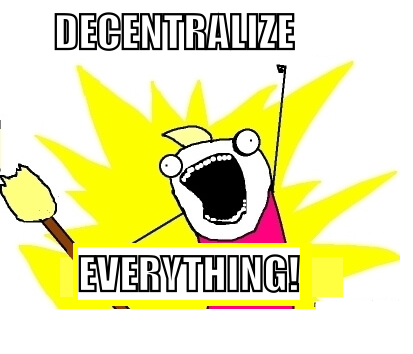Web 3 - The promise of a Decentralised Marketplace
Web3 presents the third generation of the Internet, where the World Wide Web is powered by blockchain technology: supporting Self Sovereign Identity, Decentralized Finance (DeFi), Non Fungible Tokens (NFTs) and Decentralized Autonomous Organizations (DOAs).

To paraphrase the 70’s song by Gil Scott-Heron, “The Revolution Will Not Be Televised”, we can state:
The Web3 Economy will not be centralized
Will not be centralized
Will not be centralized
Will not be centralized
Web3 will be no corporate grab, brothers
The Web3 Economy will be tokenized
One could use the analogy of The Cathedral and the Bazaar (coined by Eric Raymond) to contrast the centralized nature of interaction in a Cathedral, where you trust the Church to distribute your tithes to the poor and needy versus the Bazaar where people trade freely and directly with one another.
The pillars of the digital Decentralized Marketplaces are founded on real world counterparts:
- Self-Sovereign Identity, with Zero-Knowledge Proofs providing KYC compliance;
- Decentralized Autonomous Organizations (DAO’s) - the digital counterpart to Companies, Partnerships, etc.;
- Cryptocurrency payments based on stable coins acquired via Decentralized Exchanges
- Non-Fungible Tokens as proof of origination and transfer of ownership; and
- Smart Contracts that underpin all the above.
The blockchain as a Distributed Ledger provides the following characteristics required for companies and individuals to execute Web3 business processes:
- Decentralized: Move business processes and credentials into a modular, peer-to-peer distributed ledger architecture.
- Digital: Establish digital credentials, recognize digital events, and digitally manage actions and transactions.
- Immutable: Deploy the digital equivalent of notarized contracts in transactions, enhancing compliance, and avoiding disputes and the potential for fraud.
- Irrefutable: Leverage certified digital credentials tied to people, entities, devices and events, and the security/immutability of the blockchain, to instantly validate credentials and transactions.
2.1. Self-Sovereign Identity (SSI)
An illustration of the impact of Web3 on a simple sign-in request from a website:

In the first iteration of the WWW, websites would register your credentials in order to allow access. Web2 (the current iteration) sees the dominance of a few mega-corporations that centralized your identity credentials and allowed other website to verify your access. In Web3, SSI will allow you to manage your credential from your own digital identity wallet.
SSI provides companies with independent, cost-effective, easily accessible, instantly available and verifiable customer credentials in a digital format. SSI is particularly relevant in business processes, such as customer registration and onboarding, and validating parties in a Smart Contract for reliable and compliant business transactions. The trust established through SSI ensures that customer credentials always remain relevant and up to date, the gold standard of maintaining customer contact. Once established, customers are empowered to maintain their own Self-Sovereign Identities, eliminating costly maintenance or loss of contact. SSI also permits companies to legally and effortlessly seek the consent needed to access or share customer credentials.
Adopting the SSI paradigm ensures that customer data is decentralized and customers are given control over the use of their credentials. It is a subtle but focused transformation that ensures customers that your company is committed to a guaranteed level of reliable business transactions and trustworthiness.
2.2. Smart Contracts
Smart Contracts reside in a distributed ledger, meaning they are digitally distributed, immutable and extremely modular, thereby creating greater possibilities for efficiency. Executable pieces of code can be tailored within a Smart Contract to perform one function, and one function only, without impacting any other application in your network or back-end systems. Smart Contracts reside inside a blockchain, which means they can also be shared efficiently and reliably amongst all parties to a transaction. If your business needs to implement and enforce a business rule with a 3rd party, and you don’t want to modify any of your back-end applications doing so, then Smart Contracts are a fit for purpose solution. Even better, if you need to implement multiple business rules under a multitude of different circumstances, with multiple 3rd parties who require further conditions amongst themselves to be met, then Smart Contracts offer you an immutable, irrefutable and easy to implement digital solution.
2.3. Crypto Exchange supporting stablecoin payments and escrow
SSI will ensure KYC and trust, while smart contracts will execute on the occurrence of off-chain Oracle-ensured events. To complete the commerce circle it is necessary to affect payments for the exchange of assets. Fiat currency does not lend itself to digitization. Centralized Crypto Exchanges, like Luno or Binance, facilitates the conversion of fiat currency to crypto and back, while Crypto Wallets, like Exodus or Electrum, allow cryptocurrency to be stored (off-chain). The problem with most exchanges is that they are centralized. Escrow can be facilitated by using smart contract “owned” wallets in which future payment is guaranteed on compliance with a DSLA (Decentralized Service Level Agreement), but typical cryptocurrencies tend to fluctuate in monetary value, making it risky to pin a price on a future asset transfer, and hence the introduction of stable coins: cryptocurrencies with value pegged to a commodity or fiat currency.
2.4. Creation (minting) and transfer of Non-Fungible Tokens
NFTs are tokens that we can use to represent ownership of unique items. They let us tokenize things like art, collectibles, even real estate. They can only have one official owner at a time and they’re secured by and executed on the blockchain – no one can modify the record of ownership or copy/paste a new NFT into existence.
Real estate tokens are not new. The traditional deed of sale of a property is an NFT: it is not the property itself, it is the contractual proof of the transfer and ownership of a physical property. The Deed is lodged at the Deeds office where it is entered into the Deeds Registry. The decentralized version of the above could be publishing an ERC721 compliant token on the Ethereum network, or even better on an eUTXO blockchain like Ergo and Cardano.
Non-Fungible Tokens have the following characteristics:
- A Token that serves as proof of ownership of an asset - physical or digital;
- Allows ownership of the Token and and the underlying Asset to be transferable;
- The Token and its corresponding Asset are unique and non-interchangeable;
- Ownership of the Tokens are traceable, from origination (minting) through transfers, on an immutable distributed ledger;
- Ownership is irrefutable and irrevocable, as defined by the terms of a smart contract.
Typical use cases for NFTs are tokenizing:
- Collectables such as Sport or Music memorabilia, and digital assets such as art, music, etc. Through effective use of smart contracts limited releases can be minted, as was the case with artist creating lino prints and certifying that only 100 copies of the print will be made;
- the Rights of fair use or Distribution, with royalty disbursement to the creating parties;
- Promissory note for commissioned or future work.
